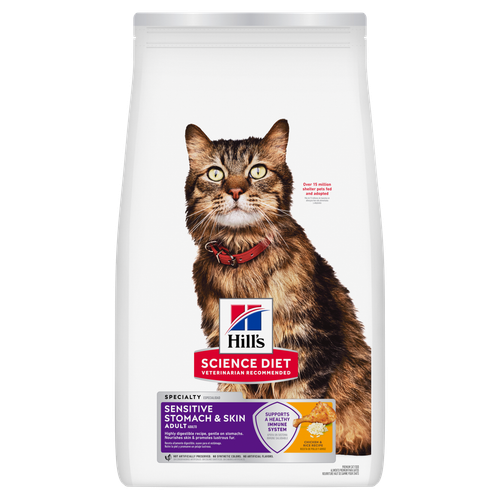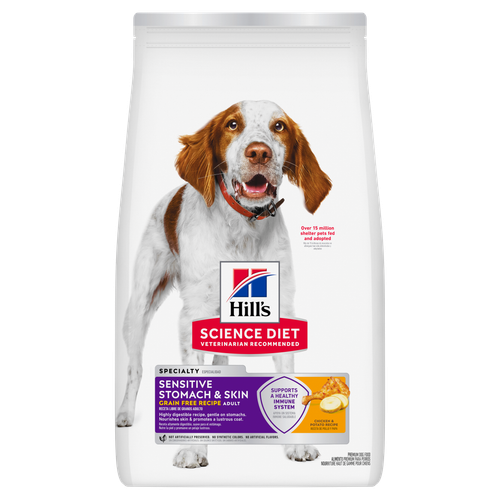
-
Find the right food for your petTake this quiz to see which food may be the best for your furry friend.Find the right food for your petTake this quiz to see which food may be the best for your furry friend.Featured products
 Adult Chicken & Barley Recipe Dog Food
Adult Chicken & Barley Recipe Dog FoodSupports lean muscle and beautiful coat for adult dogs
Shop Now Hill's Science Diet Adult Chicken & Beef Entrée Dog Food
Hill's Science Diet Adult Chicken & Beef Entrée Dog FoodChicken & Beef Entrée in a delicious loaf with complete & balanced nutrition to help keep adult dogs active and healthy
Shop Now Adult Large Breed Chicken & Barley Recipe Dog Food
Adult Large Breed Chicken & Barley Recipe Dog FoodSupports healthy joints, lean muscle, and beautiful coat for large breed dogs
Shop NowFeatured products Adult Chicken Recipe Cat Food
Adult Chicken Recipe Cat FoodSupports lean muscle and beautiful fur for adult cats
Shop Now Adult 7+ Senior Vitality Chicken & Vegetable Stew Cat Food
Adult 7+ Senior Vitality Chicken & Vegetable Stew Cat FoodImproves Everyday Ability to Get Up & Go
Shop Now Hill's Science Diet Adult Sensitive Stomach & Skin Chicken & Rice Recipe Cat Food
Hill's Science Diet Adult Sensitive Stomach & Skin Chicken & Rice Recipe Cat FoodScience-backed nutrition tailored for skin and digestive health, packed with clinically proven, immune system supporting antioxidants.
Shop Now -
Dog
- Dog Tips & Articles
-
Health Category
- Weight
- Food & Environmental Sensitivities
- Urinary
- Digestive
- Joint
- Kidney
-
Life Stage
- Puppy Nutrition
- Adult Nutrition
- Senior Nutrition
Cat- Cat Tips & Articles
-
Health Category
- Weight
- Skin & Food Sensitivities
- Urinary
- Digestive
- Kidney
-
Life Stage
- Kitten Nutrition
- Adult Nutrition
Featured articles The Science Behind Our Love for Pets
The Science Behind Our Love for PetsLearn the scientific reasons why we have such strong connections with our pets, and what science says about the love between humans and our furry friends.
Read More What Is Littermate Syndrome? Pet Adoption Guide
What Is Littermate Syndrome? Pet Adoption GuideLearn more about littermate syndrome in dogs and cats and how to successfully navigate adoption and early socialization processes.
Read More How to Properly Mix Wet & Dry Pet Foods
How to Properly Mix Wet & Dry Pet FoodsAn Orange cat eating from a bowl filled with mixed food
Read More -
Food & environmental allergies in dogs
Food & environmental allergies in dogs
Does your dog have signs of food or environmental allergies?
Dry itchy skin is just one of the many symptoms that may indicate your dog is experiencing a bigger problem brought on by environmental allergies. In rare cases, these may also be signs of food allergies in dogs. These signs can be long-term, recurring and should be noted to your vet.
















What causes allergies in dogs?
One of the most difficult things on a dog’s path to recovery is determining what is causing their allergies. There are two main types of allergies that dogs face: food and environmental. The majority of allergies in dogs are from environmental causes, but certain ingredients in food can cause reactions as well.
What causes allergies in dogs?
One of the most difficult things on a dog’s path to recovery is determining what is causing their allergies. There are two main types of allergies that dogs face: food and environmental. The majority of allergies in dogs are from environmental causes, but certain ingredients in food can cause reactions as well.


Environmental allergies
Recurring signs of environmental allergies may be caused by grasses, pollen or biting insects. They can be addressed with a multimodal treatment consisting of medication to help reduce the immediate symptoms and nutrition for effective long-term management.


Environmental allergies
Recurring signs of environmental allergies may be caused by grasses, pollen or biting insects. They can be addressed with a multimodal treatment consisting of medication to help reduce the immediate symptoms and nutrition for effective long-term management.


Food allergies
Food allergies in dogs are actually very uncommon — in fact, only 10% of dogs experience food allergies! Rarely, however, some dogs may experience reactions to certain ingredients, and they are identified through food elimination trials conducted by your veterinarian. A food elimination trial is a process of finding and removing the food ingredient causing skin issues or digestive upsets.


Food allergies
Food allergies in dogs are actually very uncommon — in fact, only 10% of dogs experience food allergies! Rarely, however, some dogs may experience reactions to certain ingredients, and they are identified through food elimination trials conducted by your veterinarian. A food elimination trial is a process of finding and removing the food ingredient causing skin issues or digestive upsets.
Managing a dog’s allergies
Managing a dog’s allergies can be a challenging process, and your first step should be visiting your veterinarian. They will help you find the right combination of nutrition, medication, and/or topicals for your dog.


Living with a dog with food or environmental allergies can cause you both to be restless, but the road to recovery will require time, patience and trust in your vet. Remember — just like humans, every dog is unique, and the best solution will come from working with a professional to address your pet’s specific needs. Together, you’ll get on the right track to helping your best friend feel like their best self.


Therapeutic nutrition plays an important role in the long-term management of allergies in dogs. The right nutrition can promote healthy skin from within and help alleviate your dog’s signs quickly and long-term. Even with treatment, some dogs may have recurring signs that will require adjustments along the way, and your veterinarian will be a helpful resource in managing your dog’s allergies.


A vet may prescribe medication to help alleviate your dog’s signs of allergies. If you are wondering what you can give your dog for allergies, only give medication as recommended by your vet.


Topicals can be used for managing allergies in dogs. There are various deliveries for topicals like shampoos, lotions, sprays or ointments. Reach out to your veterinarian to ensure a specific topical is appropriate for your pet’s skin condition and life stage.


Understanding nutritional support for food and environmental allergies
You’ll want to ask your vet about a few things when it comes to the best dog food for food or environmental allergies. For food allergies, ask about therapeutic dog food with a single novel protein or hydrolyzed protein that is unlikely to cause a reaction. For environmental allergies ask about nutrition that can nourish and help protect from environmental irritants.


Time to see a veterinarian?
If you notice behavior changes or sense something is off with your dog, it may be time to schedule a vet visit.
You also may want to ask your vet if therapeutic nutrition would be appropriate for your dog. Hill’s Prescription Diet foods are developed by a team of Ph.D. nutritionists and veterinarians, and require a vet recommendation for purchase.
Schedule an appointment so your vet can assess your pet’s health and nutritional needs.
Related products

Over 70% of dogs lost weight within 10 weeks when fed this nutrition (USA Study)

Healthy soft baked chicken flavor dog treats are a delicious complement to many Prescription Diet Dog Foods

Metabolic Treats to help support healthy weight loss and weight maintenance, and are a great complement for dogs being fed other Prescription Diet weight loss or maintenance canine food.

Science-backed nutrition tailored for skin and digestive health, packed with clinically proven, immune system supporting antioxidants.

